CHEVROLET TAHOE 1996 1.G Owners Manual
Manufacturer: CHEVROLET, Model Year: 1996, Model line: TAHOE, Model: CHEVROLET TAHOE 1996 1.GPages: 403, PDF Size: 20.63 MB
Page 211 of 403
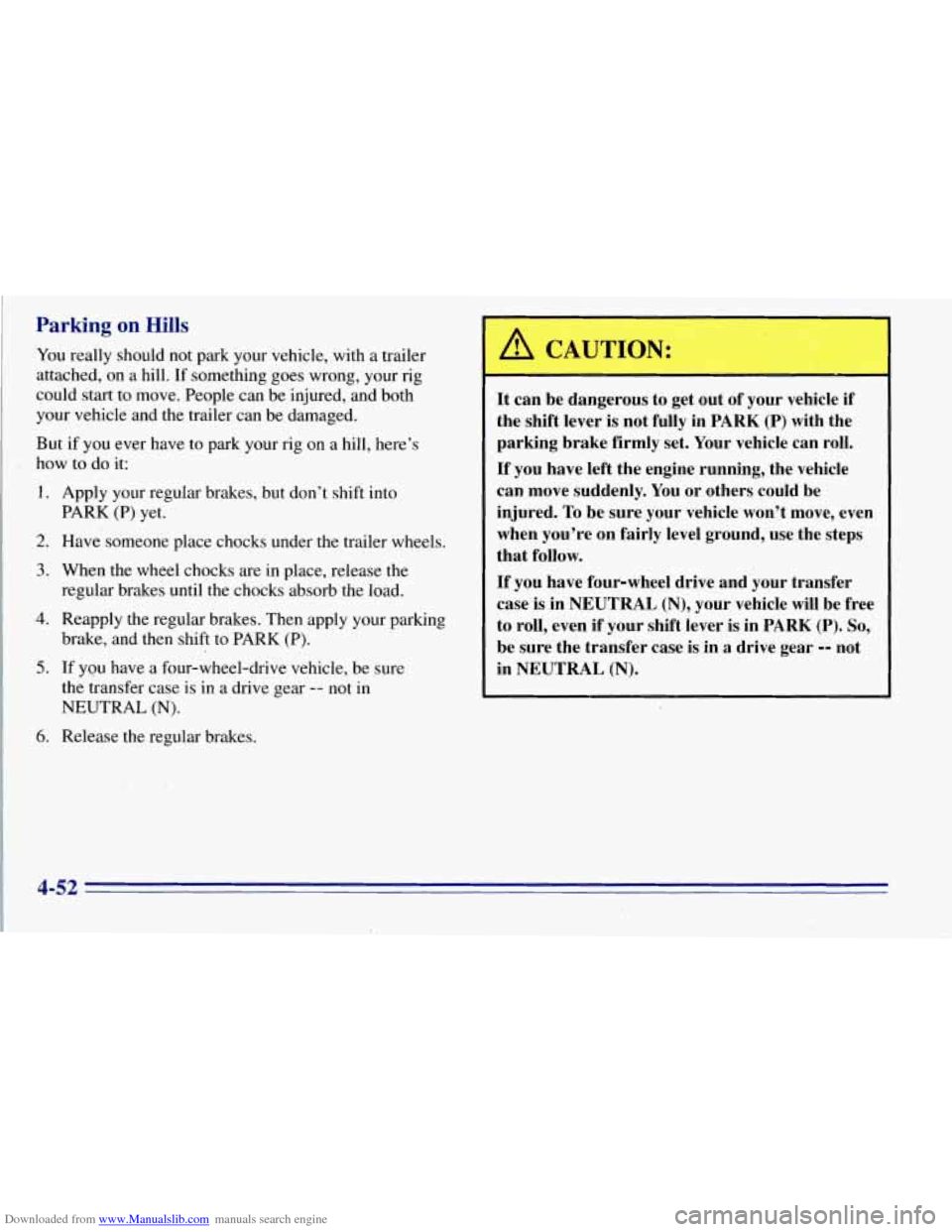
Downloaded from www.Manualslib.com manuals search engine Parking on Hills
You really should not park your vehicle, with a trailer
attached, on a hill. If something goes wrong, your rig
could start to move. People can be injured, and both
your vehicle and the trailer can be damaged.
But if you ever have to park your rig on a hill, here’s
1 how to do it:
1.
2.
3.
4.
5.
6.
Apply your regular brakes, but don’t shift into
PARK
(P) yet.
Have someone place chocks under the trailer wheels.
When the wheel chocks are in place, release the
regular brakes until the chocks absorb the load.
Reapply the regular brakes. Then apply your parking
brake, and then shift to PARK (P).
If you have a four-wheel-drive vehicle, be sure
the transfer case is in a drive gear
-- not in
NEUTRAL
(N).
Release the regular brakes.
1
I A CAUTION:
It can be dangerous to get out of your vehicle if
the shift lever
is not fully in PARK (P) with the
parking brake firmly set. Your vehicle can roll.
If you have left the engine running, the vehicle
can move suddenly. You or others could be
injured. To be sure your vehicle won’t move, even
when you’re on fairly level ground, use the steps
that follow.
If you have four-wheel drive and your transfer
case is in NEUTRAL
(N), your vehicle will be free
to roll, even if your shift lever is in
PARK (P). So,
be sure the transfer case is in a drive gear -’- not
in NEUTRAL
(N).
4-52
Page 212 of 403

Downloaded from www.Manualslib.com manuals search engine When You Are Ready to Leave After
Parking on a Hill
1. Apply your regular brakes and hold the pedal down
while you:
0 Start your engine;
Shift into a gear; and
Release the parking brake.
2. Let ,up on the brake pedal.
3. Drive slowly until the trailer is clear of the chocks.
4. Stop and have someone pick up and store the chocks.
Maintenance When Trailer Towing
Your vehicle will need service more often when you’re
pulling a trailer. See the Maintenance Schedule for more
on this. Things that are especially important in trailer
operation are automatic transmission fluid (don’t overfill), engine oil, axle lubricant, belt, cooling system
and brake adjustment. Each
of these is covered in this
manual, and the Index will help you find them qoickly.
If you’re trailering, it’s a good idea to review these
sections before you start your trip.
Check periodically to see that all hitch nuts and bolts
are tight.
Trailer Wiring Harness
A seven-wire harness is stored under the rear of your
vehicle, between the frame rails. An electrical connector
will need to be added at the trailer end
of the harness, by
a qualified electrical technician. For additional trailer
wiring and towing information, please consult your
dealer. Securely attach the harness to the trailer, then
tape or strap it to your vehicle’s frame rail. Be
sure you
leave it loose enough so the wiring won’t bind or break
when turning with the trailer, but not
so loose that it
drags on the ground. Store’ the harness in its original
position. Wrap the harness together and tie it neatly
so it
won’t be damaged.
If you tow a trailer, your Center
High-Mounted Stoplamp (CHMSL) may not be
properly visible from behind.
You should select a trailer
with a CHMSL on
it or, if one is not available, have one
installed. See your GM dealer about how to connect
your vehicle’s wiring to a trailer CHMSL.
4-53
Page 213 of 403
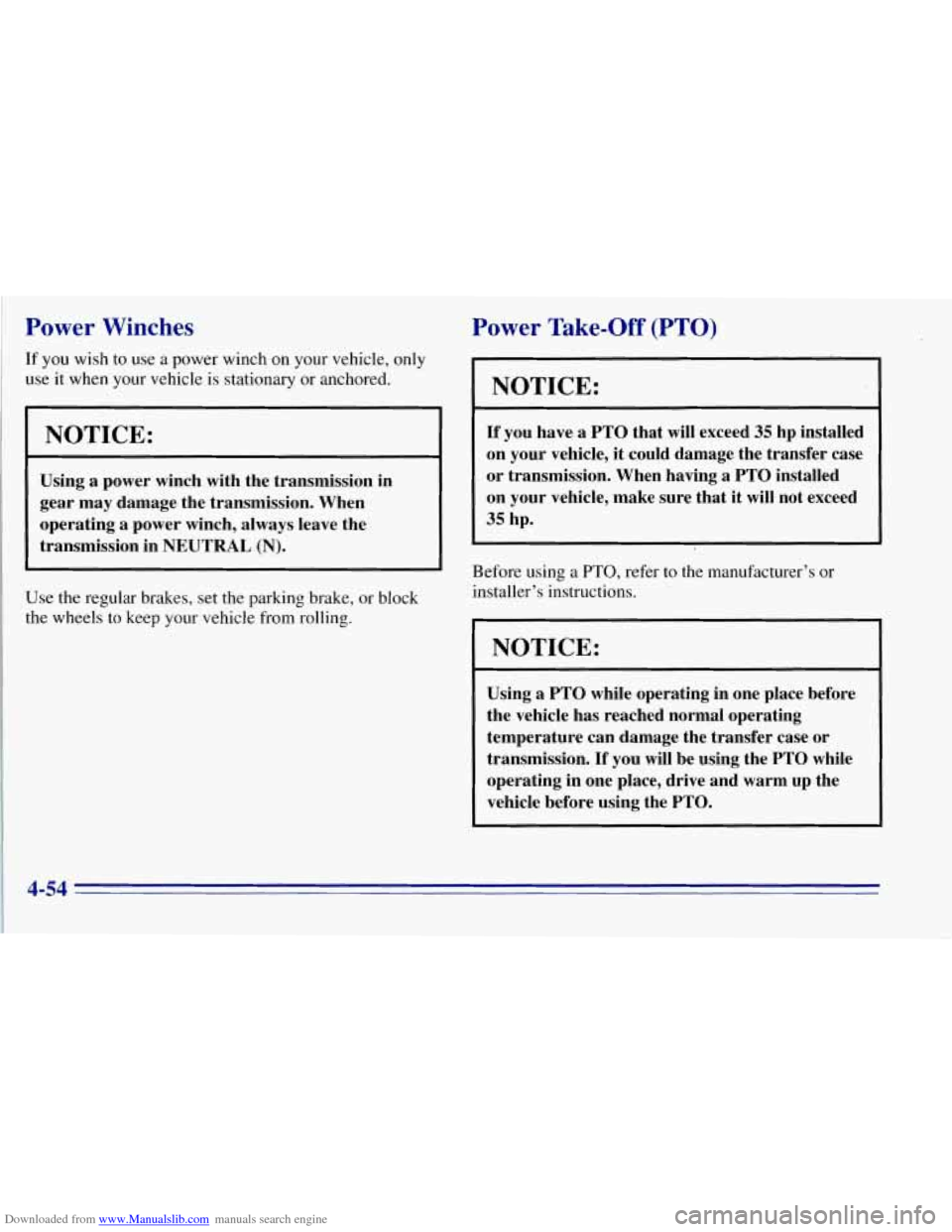
Downloaded from www.Manualslib.com manuals search engine Power Winches Power Take-Off (PTO)
If you wish to use a power winch on your vehicle, only
use it when your vehicle is stationary or anchored.
NOTICE:
Using a power winch with the transmission in
gear may damage the transmission. When
operating
a power winch, always leave the
transmission in NEUTRAL
(N).
Use the regular brakes, set the parking brake, or block
the wheels to keep your vehicle from rolling.
NOTICE:
If’ you have a PTO that will exceed 35 hp installed
on your vehicle,
it could damage the transfer case
or transmission. When having
a PTO installed
on your vehicle, make sure that
it will not exceed
35 hp.
Before using a PTO, refer to the manufacturer’s or
installer’s instructions.
NOTICE:
Using a PTO while operating in one place before
the vehicle has reached normal operating
temperature can damage the transfer case or
transmission. If you will be using the PTO while
operating in one place, drive and warm up the
vehicle before using the PTO.
4-54
Page 214 of 403
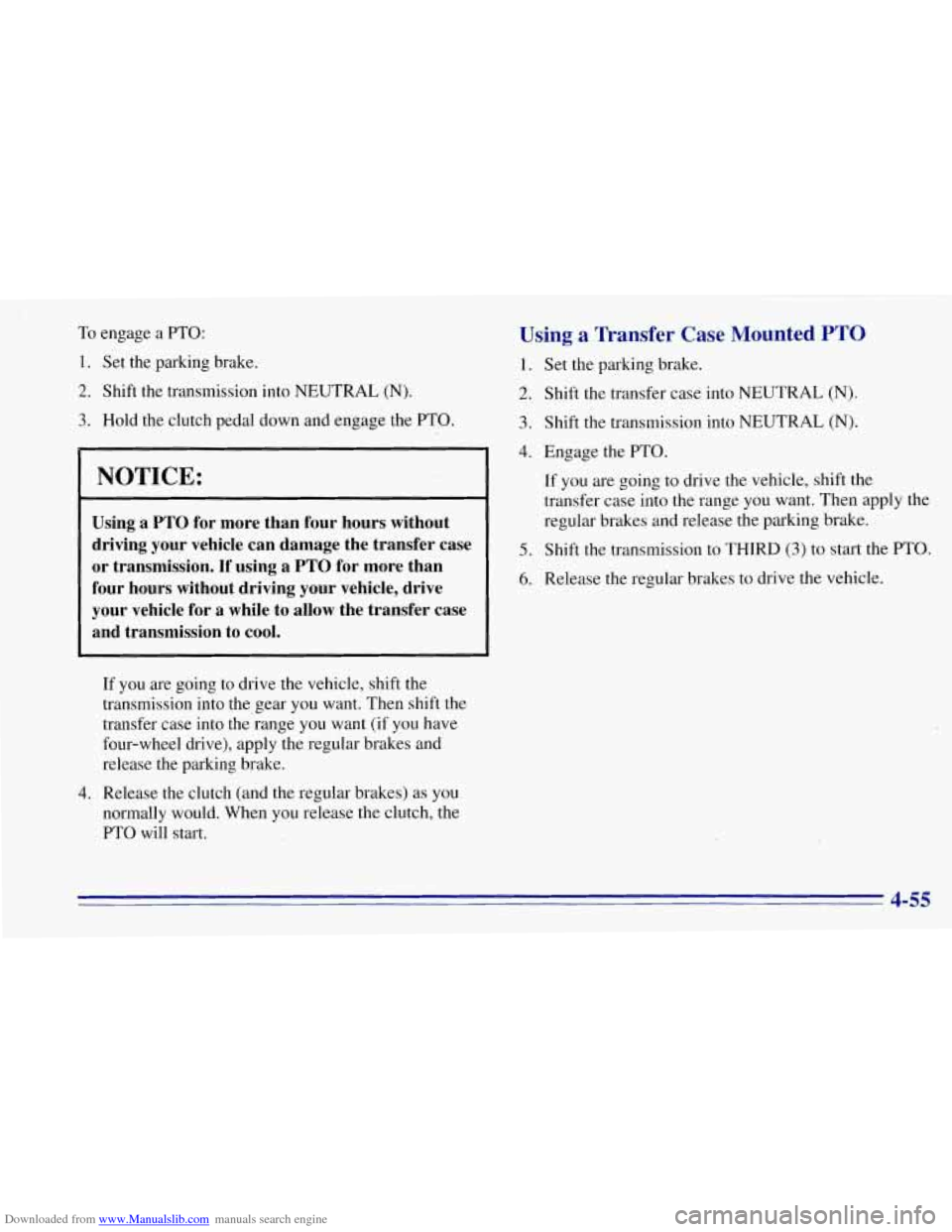
Downloaded from www.Manualslib.com manuals search engine To engage a PTO:
1. Set the parking brake.
2. Shift the transmission into NEUTRAL (N).
3. Hold the clutch pedal down and engage the PTO.
NOTICE:
Using a PTO for more than four hours without
driving your vehicle can damage the transfer case
or transmission. If using a PTO for more than
four hours without driving your vehicle, drive
your vehicle for a while
to allow the transfer case
and transmission to
cool.
If you are going to drive the vehicle, shift the
transmission into the,gear
you want. Then shift the
transfer case into the range
you want (if you have
four-wheel drive), apply the regular brakes and
release the parking brake.
4. Release the clutch (and the regular brakes) as you
normally would. When you release the clutch, the
PTO will start.
Using a Transfer Case Mounted PTO
1. Set the parking brake.
2. Shift the transfer case into NEUTRAL (N).
3. Shift the transmission into NEUTRAL (N).
4. Engage the PTO.
If you are going to drive the vehicle, shift the
transfer case into the range
you want. Then apply the
regular brakes and release the parking brake.
5. Shift the transmission to THIRD (3) to start the PTO.
6. Release the regular brakes to drive the vehicle.
4-55
Page 215 of 403
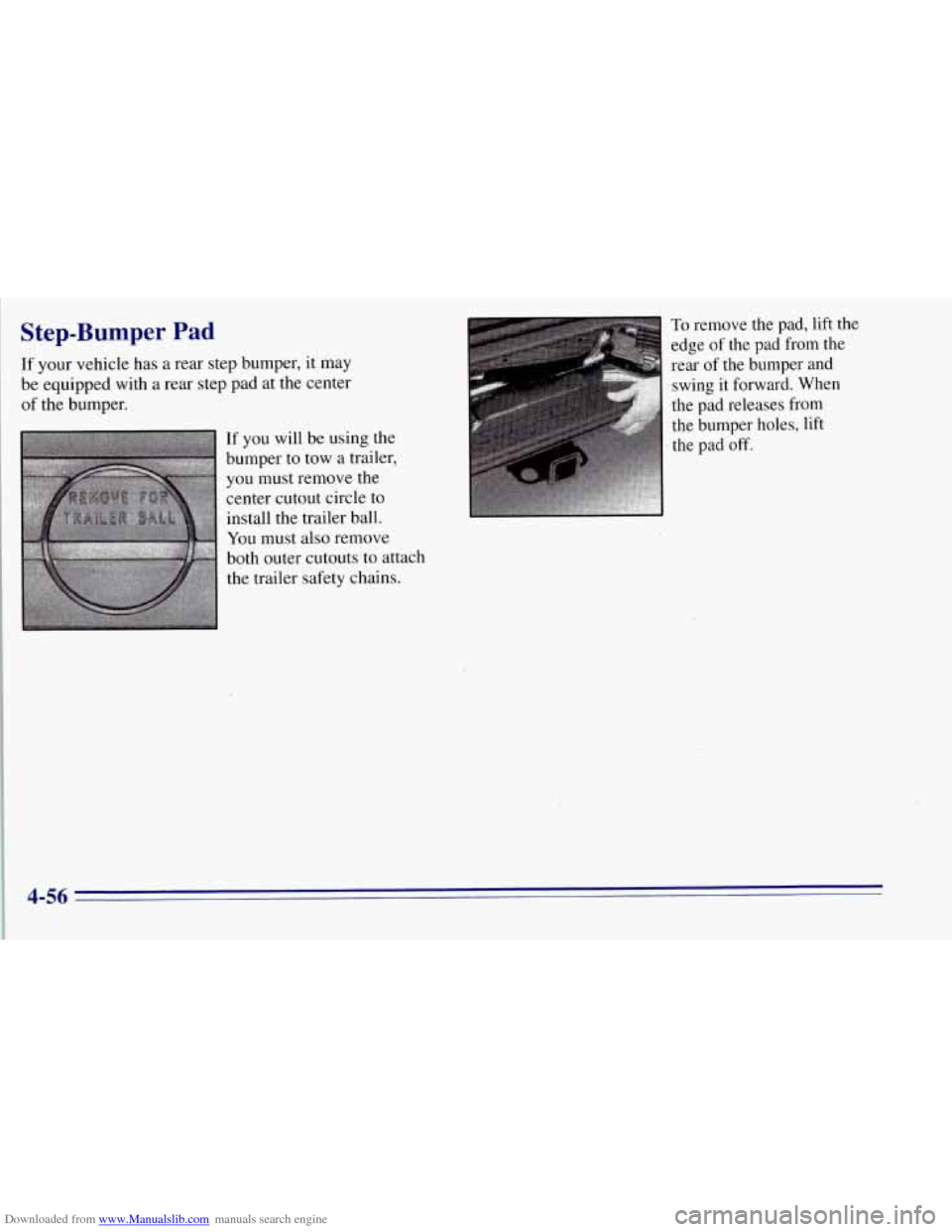
Downloaded from www.Manualslib.com manuals search engine Step-Bumper Pad
If your vehicle has a rear step bumper, it may
be equipped with a rear step pad at the center
of the bumper.
If you will
be using the
bumper
to tow a trailer,
you must remove the
center cutout circle
to
install the trailer ball.
You must also remove
both outer cutouts to attach
the trailer safety chains.
To remove the pad, lift the
edge of the pad from the
rear of the bumper and
swing it forward. When
the pad releases from
the bumper holes, lift
the pad
off.
4-56
Page 216 of 403
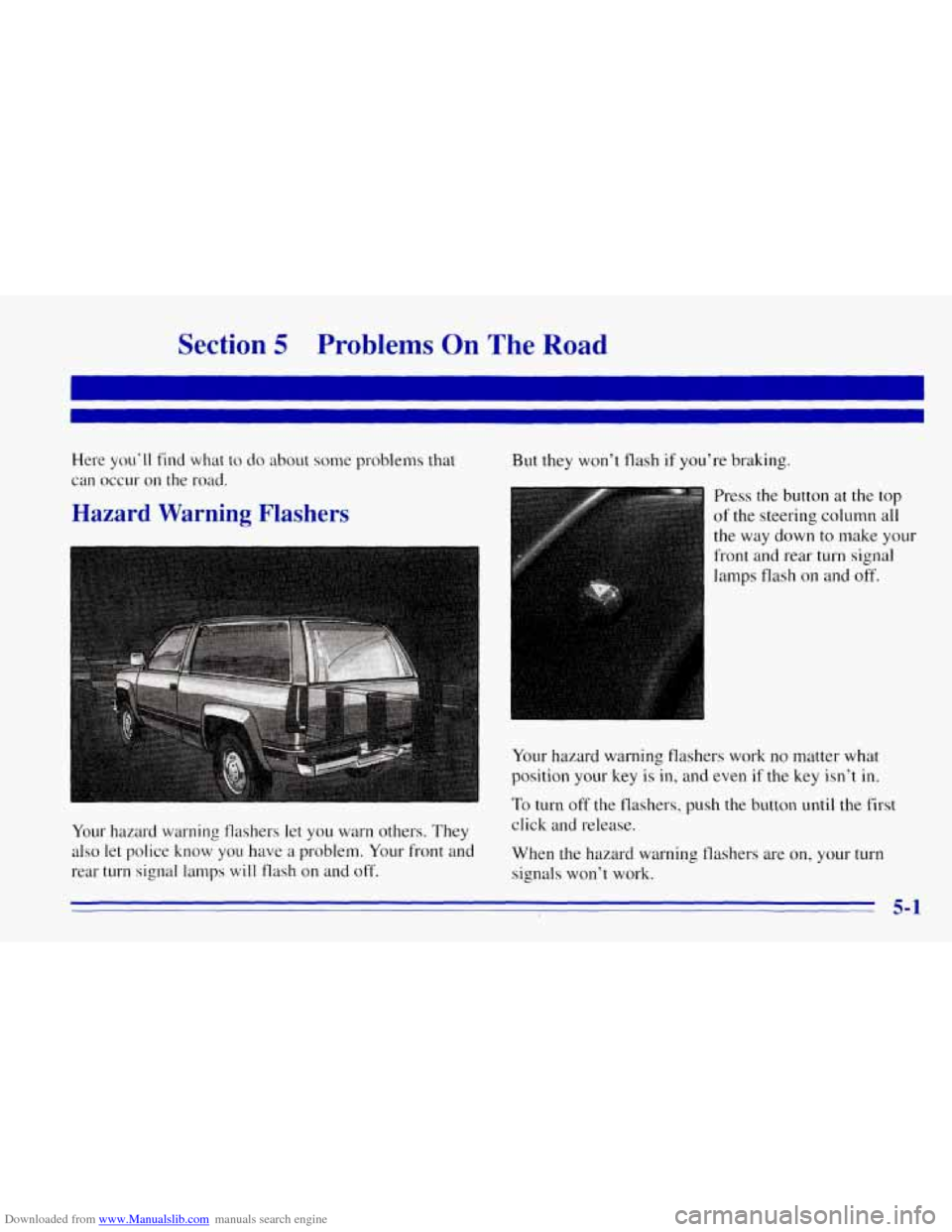
Downloaded from www.Manualslib.com manuals search engine Section 5 Problems On The Road
Here you’ll find what to do about some problems that
can occur on the road.
Hazard Warning Flashers
But they won’t flash if you’re braking.
Press the button at
the top
of the steering column all
the way down
to make your
front and rear turn signal
lamps flash
on and off.
Your hazard warning flashers work no matter what
position your key is in, and even if the key isn’t in.
To turn off the flashers, push the button until the first
Your hazard warning flashers let you warn others. They
also let police
know YOU have a problem. Your front and When the hazard warning flashers are on, your turn
rear turn signal lamps
will flash on and off. signals won’t work.
click and release.
Page 217 of 403
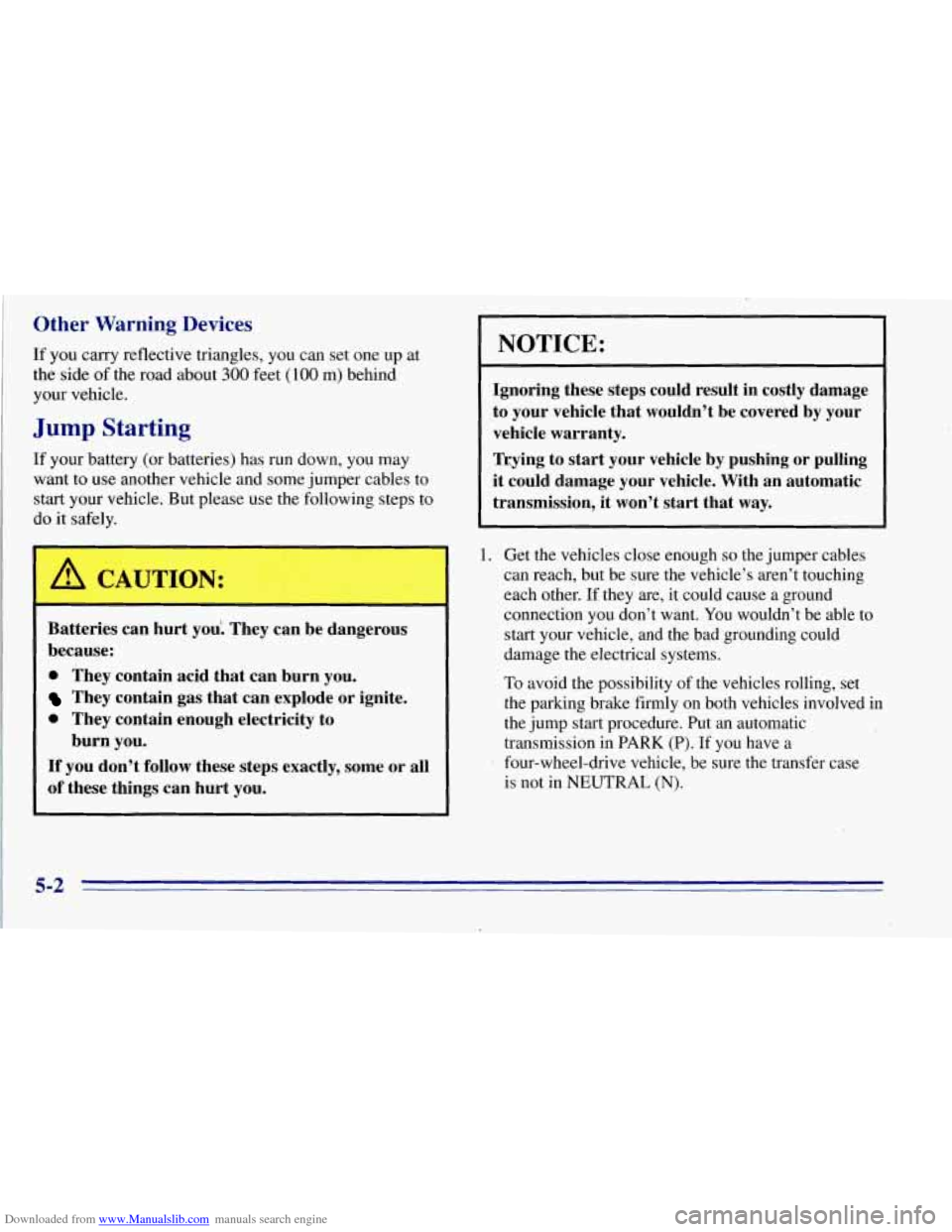
Downloaded from www.Manualslib.com manuals search engine Other Warning Devices
If you carry reflective triangles, you can set one up at .
the side of the road about 300 feet (100 m) behind
your vehicle.
Jump Starting
If your battery ,(or batteries) has run down, you may
want
to use another vehicle and some jumper cables to
start your vehicle. But please use the following steps to
do it safqly.
A CAUTION:
Batteries can hurt you! They can be dangerous
because:
0 They contain acid that can burn you.
They contain gas that can explode or ignite.
0 They contain enough electricity to
If you don’t follow these steps exactly, some or all
of these things can hurt you.
burn
you.
NOTICE:
Ignoring these steps could result in costly damage
to your vehicle that wouldn’t be covered by your
vehicle warranty.
Trying to start your vehicle by pushing or pulling
it could damage your vehicle. With an automatic
transmission,
it won’t start that way.
1. Get the vehicles close enough so the jumper cables
can reach, but be sure the vehicle’s aren’t touching
each other. If they are, it could cause a ground
connection you don’t want. You wouldn’t be able to
start your vehicle, and the bad grounding could
damage the electrical systems.
To avoid the possibility
of the vehicles rolling, set
the parking brake firmly on both vehicles involved in
the jump start procedure. Put an automatic
transmission in
PARK (P). If you have a
four-wheel-drive vehicle, be sure the transfer case
is not in NEUTRAL (N).
5-2
Page 218 of 403
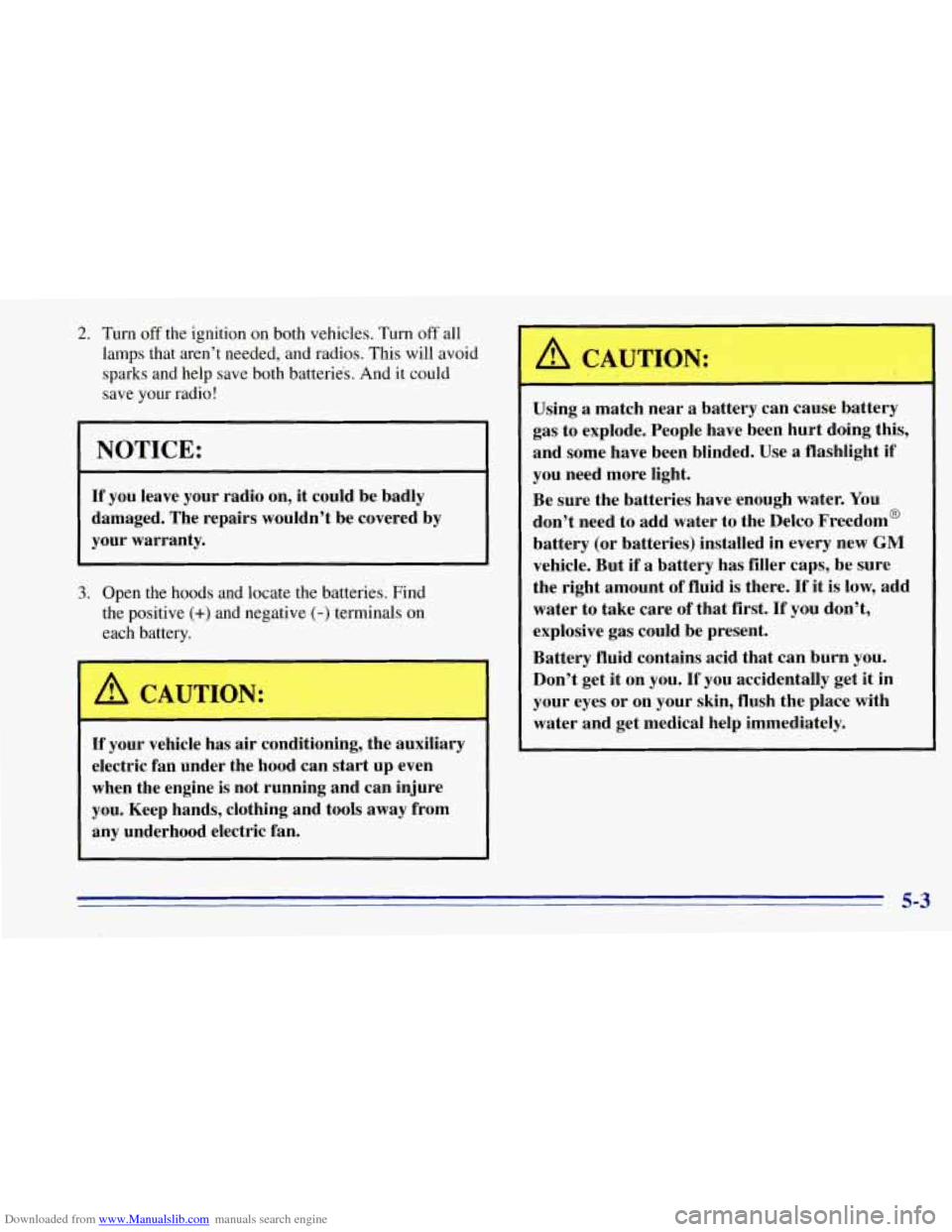
Downloaded from www.Manualslib.com manuals search engine 2. Turn off the ignition on both vehicles. Turn off all
lamps that aren’t needed, and radios. This will avoid
sparks and help save both batteries. And it could
save your radio!
NOTICE: I
If you leave your radio on, it could be badly
damaged. The repairs wouldn’t be covered by
your warranty.
3. Open the hoods and locate the batteries’. Find
the positive
(+) and negative (-) terminals on
each battery.
A CAUTION:
If your vehicle has air conditioning, the auxiliary
electric fan under the hood can start up even
when the engine is not running and can injure
you. Keep hands, clothing and tools away from
any underhood electric fan.
~
A CAUTION:
-
Using a match near a battery can cause battery
gas to explode. People have been hurt doing this,
and some have been blinded. Use a flashlight if
you need more light.
Be sure the batteries have enough water. You
don’t need to add water to the Delco Freedom@
battery (or batteries) installed in every new
GM
vehicle. But if a battery has filler caps, be sure
the right amount of fluid is there.
If it is low, add
water to take care of that first.
If you don’t,
explosive
gas could be present.
Battery fluid contains acid that can burn
you.
Don’t get it on you. If you accidentally get it in
your eyes or on your skin, flush the place with
water and get medical help immediately.
5-3
Page 219 of 403
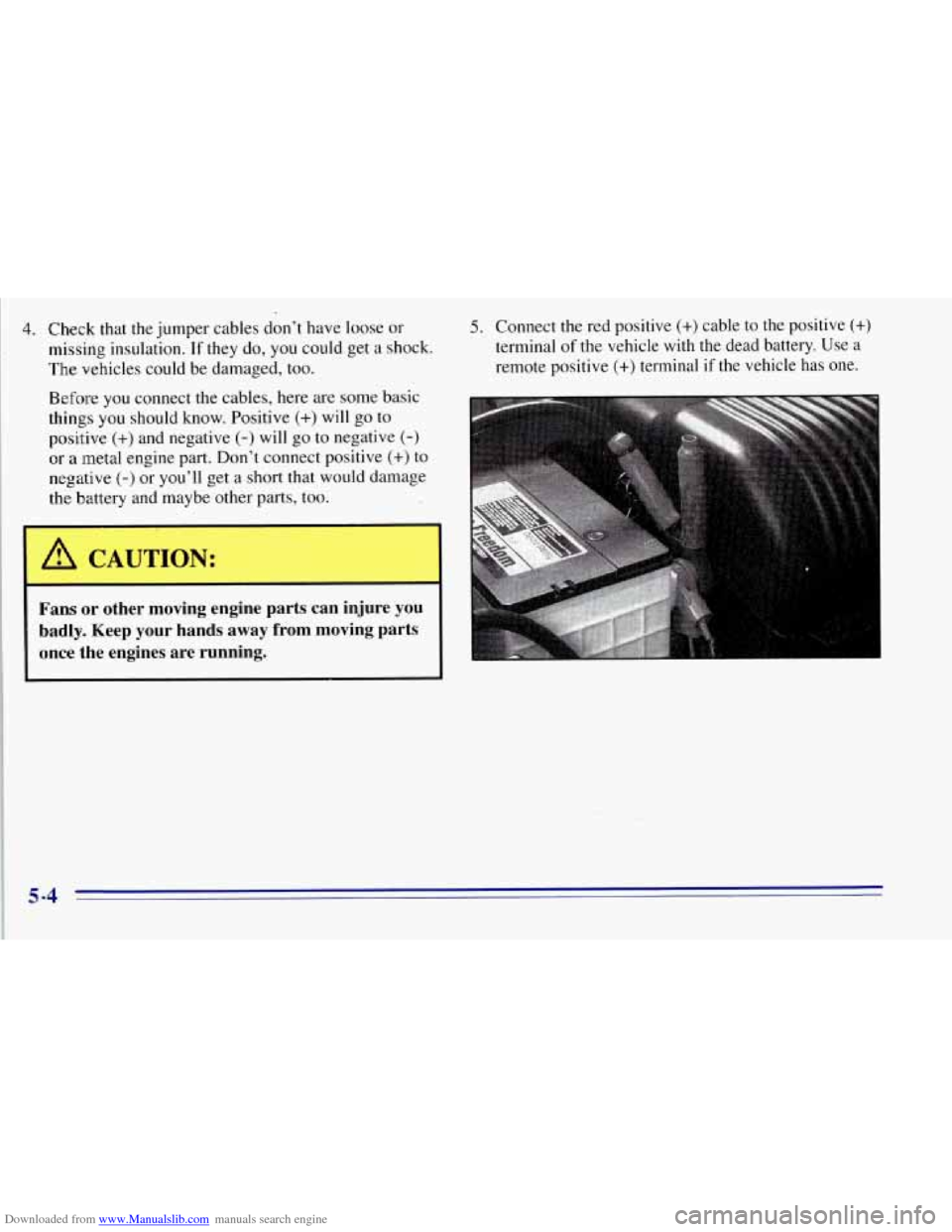
Downloaded from www.Manualslib.com manuals search engine 4. Check that the jumper cables don’t have loose or
missing insulation.
If they do, you could get a shock.
The vehicles could be damaged, too.
Before you connect
the cables, here are some basic
things you should know. Positive (+) will go to
positive
(+) and negative (-) will go to negative (-)
or a metal engine part. Don’t connect positive (+) to
negative
(-) or you’ll get a short that would damage
the battery and maybe other parts, too.
I A CAUTION:
Fans or other moving engine parts can injure you
badly. Keep your hands away from moving parts
once the engines are running.
5. Connect the red positive (+) cable to the positive (+)
terminal of the vehicle with the dead battery. Use a
remote positive
(+) terminal if the vehicle has one.
5-4
Page 220 of 403
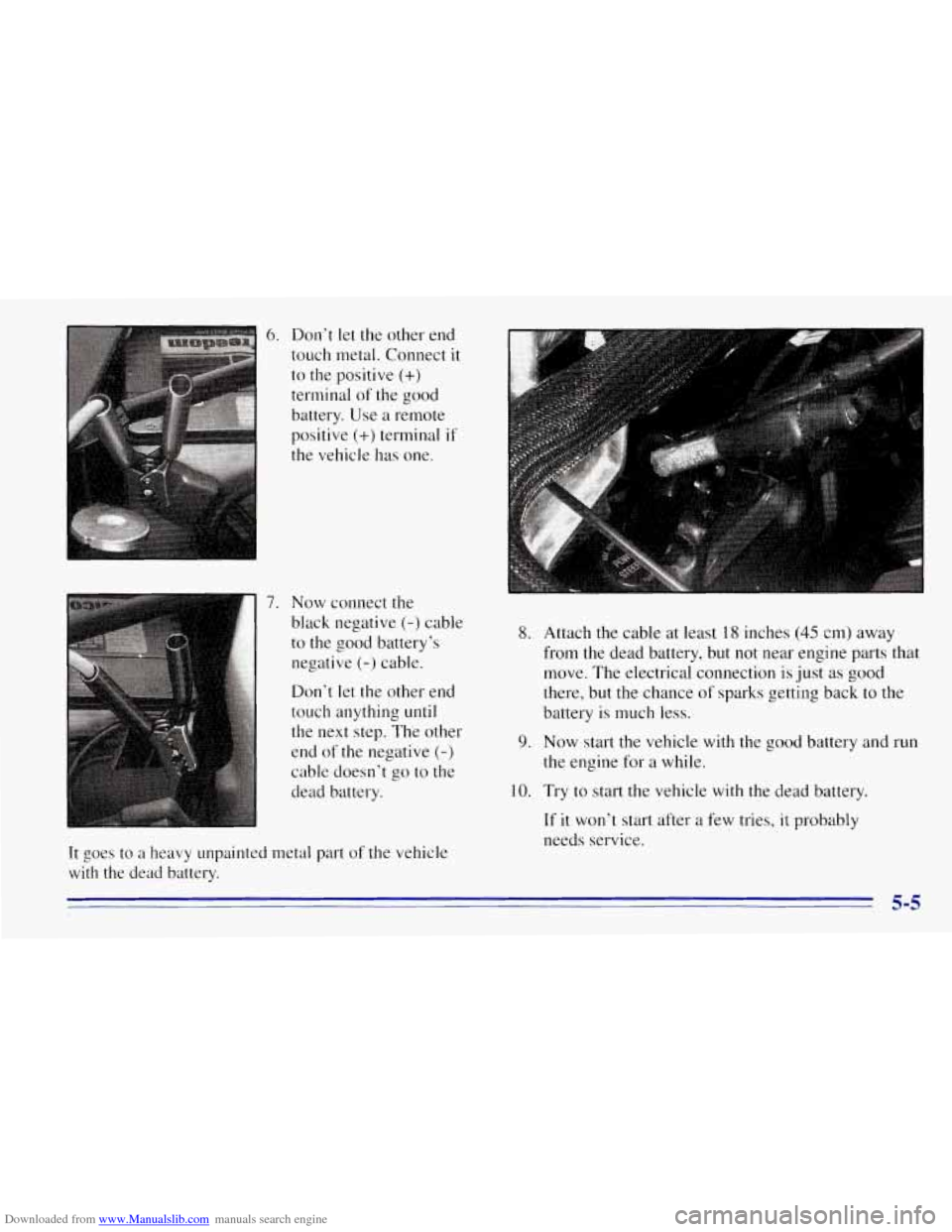
Downloaded from www.Manualslib.com manuals search engine 6. Don’t let the other end
touch metal. Connect
it
to the positive (+)
terminal of the good
battery. Use a remote
positive
(+) terminal if
the vehicle has one.
7. Now connect the
black negative
(-) cable
to the good battery’s
negative
(-) cable.
Don’t let the other end
touch anything until
the next step. The other
end of the negative
(-)
cable doesn’t go to the
dead battery.
It goes to a heavy unpainted metal part of the vehicle
with the dead battery.
8. Attach the cable at least 18 inches (45 cm) away
from the dead battery, but not near engine parts that
move. The electrical connection is just as good
there, but the chance
of sparks getting back to the
battery is much less.
9. Now start the vehicle with the good battery and run
the engine for a while.
10. Try to start the vehicle with the dead battery.
If it won’t start after a few tries, it probably
needs service.
5-5